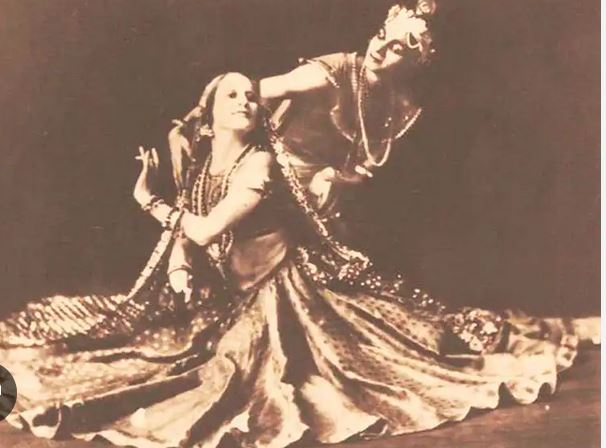

Ed. note: This story by Debra Levine, commissioned and previously published by the Younes & Soraya Nazarian Center for the Arts, is reprinted with permission.
The similarities are uncanny. By 1913, Anna Pavlova, the eternal exemplar of classical-ballet artistry, having danced with the Russian Imperial Ballet and, briefly, with Diaghilev’s Ballets Russes, took a handful of fellow dancers with her on the road. Twenty years later, Pavlova had brought ballet to the U.S., South America, Asia and, of course, Europe, inspiring the love of dance in far-flung destinations (among the girls enchanted by Pavlova in Los Angeles was Agnes de Mille). As an empowered woman of the arts, Pavlova retained creative control over performances and even choreographed her own roles.
One hundred ten years later — enter ballerina Tiler Peck. Over the past two decades, the 34-year-old brunette ballerina has stood out as a most elegant and fleet-footed of New York City Ballet principal dancers. Yes, that math is correct. Peck joined City Ballet at age fifteen, and, four years later, at nineteen, was named a principal. Still with NYCB, she has fashioned a boutique touring company, of which she is the dancing star. “Turn It Out With Tiler Peck & Friends” will enjoy a two-show run at The Soraya on Saturday evening October 28 followed by a Sunday matinee, October 29.
Tiler Peck caught the same bug that spurred Pavlova, along with many ballet superstars (famously, “Nureyev & Friends” in the 1980s) to bring small-scale, intimate performances to widespread audiences. But other similarities exist as well. Keenly interested in global dance forms, Pavlova invited on her tours in the mid-1920s the great Indian dancer Uday Shankar (brother to Ravi Shankar and uncle to Anoushka Shankar, who will perform at The Soraya on October 22). The two co-choreographed and performed three Indian-inspired pieces, both garbed in Indian costume.
“Turn It Out With Tiler Peck & Friends” follows this lead with its own diverse talent roster across a spectrum of dance genres. Tap-dance diva Michelle Dorrance is among the evening’s four choreographers, and she dances in the show as well — her first appearance at The Soraya. Lex Ishimoto, a SYTYCD Season 14 winner, is a killer hip-hop guy from Irvine, California. But balletomanes needn’t worry; a crème de le crème of classical whizz kids will populate the show. Among others, they are Mira Nadon, who just inherited iconic NYCB roles in “Jewels” and “Apollo”; Brooklyn Mack, in the vanguard of Black classical dance; Chun Wai Chan, City Ballet’s first principal dancer from China in its 75-year history; and Jillian Meyers, assistant choreographer on La La Land who choreographed for Madonna.
“I didn’t want it just to be just a gala, with a bunch of pas de deuxs, although that can be very beautiful,” said Peck. “I wanted a cohesive through line.” She turned to a friend for advice. “I actually talked to Misha…Baryshnikov. He said, ‘Well there has to be one of your works on the program.’ I thought, there’s no way I can hold my own with William Forsythe, Alonzo King and Michelle Dorrance.”
Surprisingly, Baryshnikov pushed back. “It makes sense,” he told her. “You can’t be in every part of the show [as a dancer]. But you are a choreographer; you’re a budding one.” Peck thought it through. “After a while,” she said, “I went with his suggestion.” That is why we’ll see Tiler Peck’s Thousandth Orange as an opening number, set to music by Pulitzer-prize winner Caroline Shaw, performed live by a string quartet.


Tiler Peck and Roman Mejia. Photograph: Tristram Kenton/The Guardian
Anna Pavlova, Uday Shankar courtesy Internet
King’s pas de deux, Swift Arrow, has jazz music by Jason Moran, who has often performed at The Soraya. “Tiler is a warm and engaging person — as magnetic as she is on stage, she is as a human being,” said King. “She surrounds herself with brilliance and humanity.”
Time Spell, Michelle Dorrance’s contribution, follows suit, sure to be an explosion of rhythm and sound. The final work, Forsythe’s The Barre Project, is the result of Peck’s long yearning to work with the brilliant, uber-modern choreographer. The pair Zoomed four times a week, a hugely difficult way to learn any dance, especially one by Forsythe, evincing extreme technical virtuosity.
These leaps of faith are familiar to Peck, who, at age eleven, danced and sang on Broadway nightly in a revival of The Music Man. By day she repaired to the School of American Ballet for classes. Despite a few fellow bunheads looking at her askance as a “jazzerina,” Peck pressed on. Her mother had been her first ballet instructor at the family’s Bakersfield dance studio. Deeper study was undertaken in six-hour round-trip daily commute, Bakersfield to Downey, to study with a former Bolshoi dancer. Two great Balanchine alumni also trained Peck: Patricia Neary and Yvonne Mounsey, both at the school of the Westside Ballet in Santa Monica.
Dance critic Marina Harss, who just reviewed Peck in leading roles in the Balanchine canon at Lincoln Center last week, called her, “a whirlwind, but also the epitome of the ballerina, in control, brilliant, and expansive.” Indeed, Tiler Peck is a true phenom. Her “Turn It Out with Tiler” classes went viral during the pandemic in 2020, reaching up to 15,000 daily participants on Instagram live. Her children’s book, Katarina Ballerina, Simon & Schuster published in 2020. Peck has three licensed clothing lines, and for one Peck herself poses as the catalogue model, “sur les pointes” donning outfits she herself designed. Now adding “producer” to her resume, is it possible we’ll all look back, back one hundred years hence, in admiration of Peck and her place in art and culture?
Turn It Out With Tiler Peck & Friends | The Soraya | Oct 28, 29
